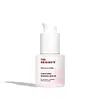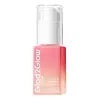What's inside
What's inside
 Key Ingredients
Key Ingredients

 Benefits
Benefits

 Concerns
Concerns

 Ingredients Side-by-side
Ingredients Side-by-side

Water
Skin ConditioningButylene Glycol
HumectantGlycerin
Humectant1,2-Hexanediol
Skin ConditioningHydroxyacetophenone
AntioxidantAcetyl Glucosamine
Skin ConditioningNiacinamide
SmoothingHydroxyethylcellulose
Emulsion StabilisingAllantoin
Skin ConditioningCentella Asiatica Extract
CleansingSodium Hyaluronate
HumectantBeta-Glucan
Skin ConditioningStephania Tetrandra Root Extract
Skin ConditioningScutellaria Baicalensis Root Extract
AstringentPolygonum Cuspidatum Root Extract
AntioxidantPEG-40 Hydrogenated Castor Oil
EmulsifyingCamellia Sinensis Leaf Extract
AntimicrobialGlycyrrhiza Glabra Root Extract
BleachingChamomilla Recutita Flower Extract
MaskingRosmarinus Officinalis Leaf Extract
AntimicrobialCaprylic/Capric Triglyceride
MaskingHydrogenated Lecithin
EmulsifyingPolysorbate 20
EmulsifyingHexylene Glycol
EmulsifyingStearic Acid
CleansingCholesterol
EmollientCeramide NP
Skin ConditioningPropolis Extract
Skin ConditioningRosa Canina Fruit Oil
EmollientTocopherol
AntioxidantPropanediol
SolventEthylhexylglycerin
Skin ConditioningCaprylyl Glycol
EmollientCI 16255
Cosmetic ColorantPalmitoyl Tripeptide-1
Skin ConditioningArginine/Lysine Polypeptide
Skin ConditioningWater, Butylene Glycol, Glycerin, 1,2-Hexanediol, Hydroxyacetophenone, Acetyl Glucosamine, Niacinamide, Hydroxyethylcellulose, Allantoin, Centella Asiatica Extract, Sodium Hyaluronate, Beta-Glucan, Stephania Tetrandra Root Extract, Scutellaria Baicalensis Root Extract, Polygonum Cuspidatum Root Extract, PEG-40 Hydrogenated Castor Oil, Camellia Sinensis Leaf Extract, Glycyrrhiza Glabra Root Extract, Chamomilla Recutita Flower Extract, Rosmarinus Officinalis Leaf Extract, Caprylic/Capric Triglyceride, Hydrogenated Lecithin, Polysorbate 20, Hexylene Glycol, Stearic Acid, Cholesterol, Ceramide NP, Propolis Extract, Rosa Canina Fruit Oil, Tocopherol, Propanediol, Ethylhexylglycerin, Caprylyl Glycol, CI 16255, Palmitoyl Tripeptide-1, Arginine/Lysine Polypeptide
Water
Skin ConditioningButylene Glycol
HumectantPropylene Glycol
HumectantCaprylic/Capric Glycerides Polyglyceryl-10 Esters
EmollientBetaine
HumectantPrunus Persica Fruit Extract
AbrasiveSqualane
EmollientMadecassoside
AntioxidantRetinol
Skin ConditioningHydroxyacetophenone
Antioxidant1,2-Hexanediol
Skin ConditioningCetearyl Olivate
Pentylene Glycol
Skin ConditioningSorbitan Olivate
EmulsifyingAcrylates/C10-30 Alkyl Acrylate Crosspolymer
Emulsion StabilisingAllantoin
Skin ConditioningO-Cymen-5-Ol
AntimicrobialXanthan Gum
EmulsifyingAminomethyl Propanol
BufferingRetinyl Propionate
Skin ConditioningHydroxypinacolone Retinoate
Skin ConditioningHydroxyphenyl Propamidobenzoic Acid
Skin ConditioningAroma
Quaternium-73
Glycerin
HumectantCaprylic/Capric Triglyceride
MaskingPolysorbate 80
EmulsifyingPolysorbate 20
EmulsifyingPhenoxyethanol
PreservativeEthylhexylglycerin
Skin ConditioningWater, Butylene Glycol, Propylene Glycol, Caprylic/Capric Glycerides Polyglyceryl-10 Esters, Betaine, Prunus Persica Fruit Extract, Squalane, Madecassoside, Retinol, Hydroxyacetophenone, 1,2-Hexanediol, Cetearyl Olivate, Pentylene Glycol, Sorbitan Olivate, Acrylates/C10-30 Alkyl Acrylate Crosspolymer, Allantoin, O-Cymen-5-Ol, Xanthan Gum, Aminomethyl Propanol, Retinyl Propionate, Hydroxypinacolone Retinoate, Hydroxyphenyl Propamidobenzoic Acid, Aroma, Quaternium-73, Glycerin, Caprylic/Capric Triglyceride, Polysorbate 80, Polysorbate 20, Phenoxyethanol, Ethylhexylglycerin
Ingredients Explained
These ingredients are found in both products.
Ingredients higher up in an ingredient list are typically present in a larger amount.
1,2-Hexanediol is a synthetic liquid and another multi-functional powerhouse.
It is a:
- Humectant, drawing moisture into the skin
- Emollient, helping to soften skin
- Solvent, dispersing and stabilizing formulas
- Preservative booster, enhancing the antimicrobial activity of other preservatives
Allantoin is a soothing ingredient known for its protective and moisturizingg properties. Because of this, it is often added to products with strong active ingredients.
Studies show higher concentrations of this ingredient can promote wound healing.
Though it can be derived from the comfrey plant, allantoin is produced synthetically for cosmetic products to ensure purity.
Learn more about AllantoinButylene Glycol (or BG) is used within cosmetic products for a few different reasons:
Overall, Butylene Glycol is a safe and well-rounded ingredient that works well with other ingredients.
Though this ingredient works well with most skin types, some people with sensitive skin may experience a reaction such as allergic rashes, closed comedones, or itchiness.
Learn more about Butylene GlycolThis ingredient is an emollient, solvent, and texture enhancer. It is considered a skin-softener by helping the skin prevent moisture loss.
It helps thicken a product's formula and makes it easier to spread by dissolving clumping compounds.
Caprylic Triglyceride is made by combining glycerin with coconut oil, forming a clear liquid.
While there is an assumption Caprylic Triglyceride can clog pores due to it being derived from coconut oil, there is no research supporting this.
Learn more about Caprylic/Capric TriglycerideEthylhexylglycerin (we can't pronounce this either) is commonly used as a preservative and skin softener. It is derived from glyceryl.
You might see Ethylhexylglycerin often paired with other preservatives such as phenoxyethanol. Ethylhexylglycerin has been found to increase the effectiveness of these other preservatives.
Glycerin is already naturally found in your skin. It helps moisturize and protect your skin.
A study from 2016 found glycerin to be more effective as a humectant than AHAs and hyaluronic acid.
As a humectant, it helps the skin stay hydrated by pulling moisture to your skin. The low molecular weight of glycerin allows it to pull moisture into the deeper layers of your skin.
Hydrated skin improves your skin barrier; Your skin barrier helps protect against irritants and bacteria.
Glycerin has also been found to have antimicrobial and antiviral properties. Due to these properties, glycerin is often used in wound and burn treatments.
In cosmetics, glycerin is usually derived from plants such as soybean or palm. However, it can also be sourced from animals, such as tallow or animal fat.
This ingredient is organic, colorless, odorless, and non-toxic.
Glycerin is the name for this ingredient in American English. British English uses Glycerol/Glycerine.
Learn more about GlycerinHydroxyacetophenone is antioxidant with skin conditioning and soothing properties. It also boosts the efficiency of preservatives.
This ingredient is not irritating or sensitizing.
Polysorbate 20 is made by combining ethoxylation of sorbitan, ethylene oxide, and lauric acid. It is a mild cleansing agent, surfactant, and emulsifier.
As a surfactant, it helps collect dirt and oils for washing. Emulsifiers prevent oils and water from separating.
Polysorbate 20 also adds scent to a product. Since it is made using sorbitol, it has a sweet scent. Sorbitol can also be found in fruits such as apples and peaches.
The lauric acid used to create Polysorbate 20 is often derived from coconuts.
Polysorbate 20 may not be fungal acne safe.
Learn more about Polysorbate 20Water. It's the most common cosmetic ingredient of all. You'll usually see it at the top of ingredient lists, meaning that it makes up the largest part of the product.
So why is it so popular? Water most often acts as a solvent - this means that it helps dissolve other ingredients into the formulation.
You'll also recognize water as that liquid we all need to stay alive. If you see this, drink a glass of water. Stay hydrated!
Learn more about Water